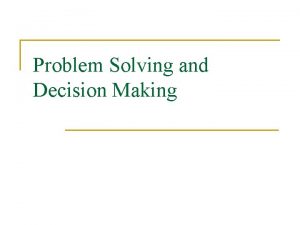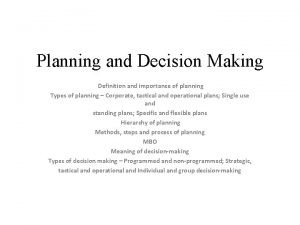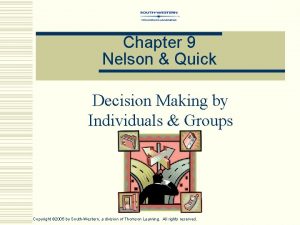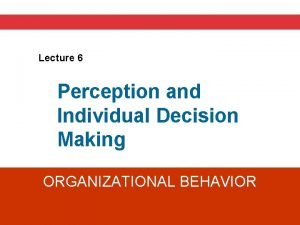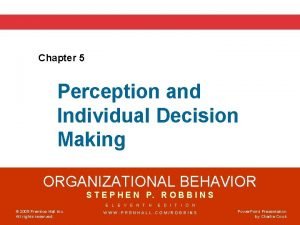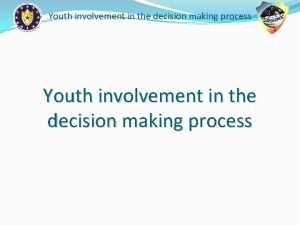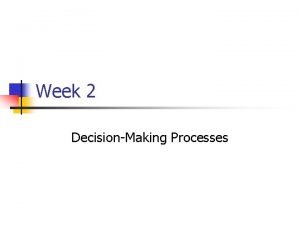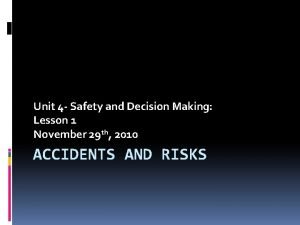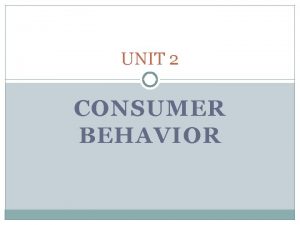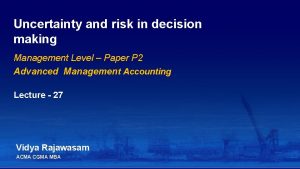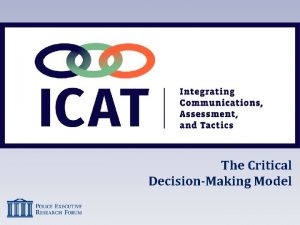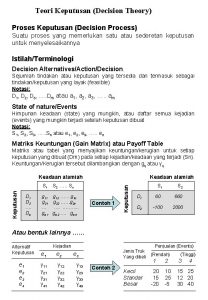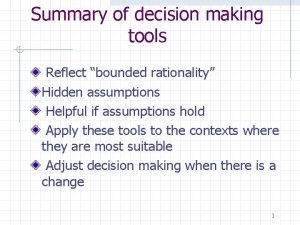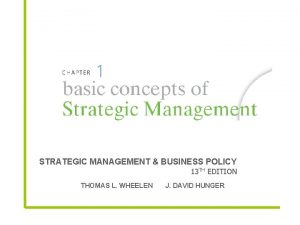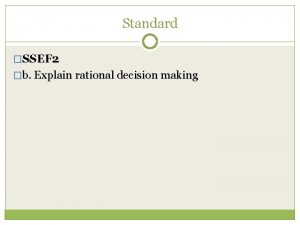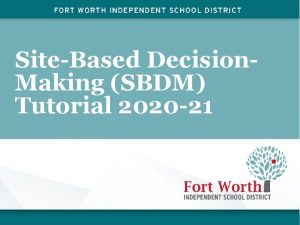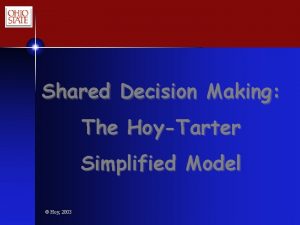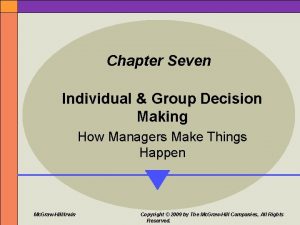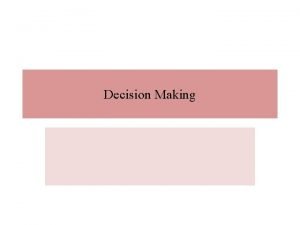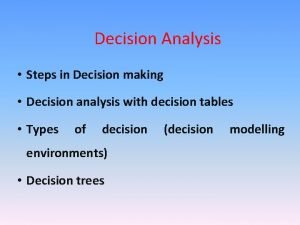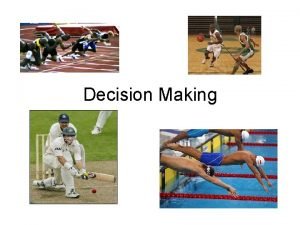Individual Group Decision Making How Managers Make Things








































- Slides: 40

Individual & Group Decision Making How Managers Make Things Happen Chapter Seven Mc. Graw-Hill/Irwin Copyright © 2013 by The Mc. Graw-Hill Companies, Inc. All rights reserved.

Major Questions You Should Be Able to Answer 7. 1 How do people know when they’re being logical or illogical? 7. 2 How can I improve my decision making using evidence-based management and business analytics? 7. 3 How do I decide to decide? 7 -*

Major Questions You Should Be Able to Answer 7. 4 What guidelines can I follow to be sure that decisions I make are not just lawful but ethical? 7. 5 Trying to be rational isn’t always easy. What are the barriers? 7. 6 How do I work with others to make things happen? 7 -*

Two Kinds of Decision Making ✦Decision 9 choice made from among available alternatives ✦Decision making 9 process of identifying and choosing alternative courses of action 7 -*

Rational Decision Making Figure 7. 1 7 -*

Rational Decision Making ✦Rational model of decision making 9 explains how managers should make decisions 9 assumes managers will make logical decisions that will be optimum in furthering the organization’s interest 9 also called the classical model 7 -*

Example: What Do Warren Buffett & Female Investors Have in Common? ✦Buffett and female investors have something in common. ✦Women trade much less often than men, do a lot more research, and tend to base their investment decisions on more than just numbers. ✦Men tend to be frazzled, frenetic day traders. 7 -*

Assumptions of the Rational Model Table 7. 1 7 -*

Nonrational Decision Making ✦Nonrational models of decision making 9 assume that decision making is nearly always uncertain and risky, making it difficult for managers to make optimal decisions 7 -*

Bounded Rationality ✦Bounded Rationality 9 suggests that the ability of decision makers to be rational is limited by numerous constraints 9 complexity, time and money, cognitive capacity 7 -*

Some Hindrances to Perfectly Rational Decision Making Figure 7. 2 7 -*

Satisficing and Incremental Models ✦Satisficing Model 9 managers seek alternatives until they find one that is satisfactory, not optimal ✦Incremental Model 9 managers take small, short-term steps to alleviate a problem 7 -*

Intuition Model ✦Intuition 9 making a choice without the use of conscious thought or logical inference 9 sources are expertise and feelings 7 -*

Question? Bill has been a manager for 14 years. He has seen many different situations with his employees. He often makes decisions without really thinking about them. This is called _____. A. Intuition B. Satisficing C. Bounded rationality D. Unbounded rationality 7 -*

Implementation Principles of Evidence-Based Decision Making ✦Treat your organization as an unfinished prototype. ✦No brag, just facts. ✦See yourself and your organization as outsiders do. ✦Evidence-based management is not just for senior executives. 7 -*

Implementation Principles of Evidence. Based Decision Making (cont. ) ✦Like everything else, you still need to sell it ✦If all else fails, slow the spread of bad practice ✦The best diagnostic question: What happens when people fail? 7 -*

What Makes It Hard to Be Evidence Based 1. There’s too much evidence. 2. There’s not enough good evidence. 3. The evidence doesn’t quite apply. 4. People are trying to mislead you. 5. You are trying to mislead you. 6. The side effects outweigh the cure. 7. Stories are more persuasive anyway. 7 -*

Question? Norma is trying to decide on a new contract for copier services. One of the salespeople has an excellent bid, but Norma feels that there are things he is not telling her. Why does this make it hard for her to use evidence-based decision making? A. There’s too much evidence. B. There’s not enough good evidence. C. People are trying to mislead you. D. The evidence doesn’t quite apply. 7 -*

Analytics ✦Analytics 9 sophisticated forms of business data analysis 9 portfolio analysis, time-series forecast 9 also called business analytics 7 -*

Example: The Oakland A’s Play Moneyball ✦The A’s could not afford superstar free agents ✦Looked for players that could contribute in ways other clubs didn’t value as much ✦Found that indicators of success lay in onbase percentage and slugging percentage 7 -*

Key Attributes Among Analytics Competitors 1. Use of modeling: going beyond simple 2. 3. descriptive statistics Having multiple applications, not just one Support from the top 7 -*

General Decision-Making Styles ✦Risk propensity 9 the willingness to gamble or to undertake risk for the possibility of gaining an increased payoff ✦Decision-making style 9 reflects the combination of how an individual perceives and responds to information 9 value orientation 9 tolerance for ambiguity 7 -*

Decision-Making Styles Figure 7. 3 7 -*

Decision-Making Styles ✦Directive 9 people are efficient, logical, practical, and systematic in their approach to solving problems 9 action-oriented, decisive, and likes to focus on facts ✦Analytical 9 considers more information and alternatives 7 -*

Decision-Making Styles ✦Conceptual 9 takes a broad perspective to problem solving 9 likes to consider many options and future possibilities ✦Behavioral 9 supportive, receptive to suggestions, show warmth 9 prefer verbal to written information 7 -*

Question? Bill is supportive of his employees and prefers to have verbal conversations rather than written memos. His style is: A. Analytical B. Behavioral C. Conceptual D. Directive 7 -*

Which Style Do You Have? Knowledge of your decision-making style: ✦Helps you to understand yourself ✦Can increase your ability to influence others ✦Gives you an awareness of how people can take the same information and yet arrive at different decisions 7 -*

Road Map to Ethical Decision Making: A Decision Tree 1. Is the proposed action legal? 2. If “yes, ” does the proposed action maximize 3. 4. shareholder value? If “yes, ” is the proposed action ethical? If “no, ” would it be ethical not to take the proposed action? 7 -*

The Ethical Decision Tree Figure 7. 4 7 -*

Ineffective Responses to a Decision Situation 7 -*

Three Effective Reactions: Deciding to Decide ✦Importance 9 “How high priority is this situation? ” ✦Credibility 9 “How believable is the information about the situation? ” ✦Urgency 9 “How quickly must I act on the information about the situation? ” 7 -*

Common Decision-Making Biases 1. Availability bias 2. Confirmation bias 3. Representativeness bias 4. Sunk cost bias 5. Anchoring and adjustment bias 6. Escalation of commitment bias 7 -*

Advantages of Group Decision Making ✦Greater pool of knowledge ✦Different perspectives ✦Intellectual stimulation ✦Better understanding of decision rationale ✦Deeper commitment to the decision 7 -*

Disadvantages of Group Decision Making ✦A few people dominate or intimidate ✦Groupthink ✦Satisficing ✦Goal displacement 7 -*

Groupthink ✦Groupthink 9 occurs when group members strive to agree for the sake of unanimity and thus avoid accurately assessing the decision situation 7 -*

What Managers Need to Know About Groups & Decision Making ✦They are less efficient. ✦Their size affects decision quality. ✦They may be too confident. ✦Knowledge counts. 7 -*

When a Group Can Help in Decision Making Table 7. 3 7 -*

Participative Management ✦Participative Management 9 process of involving employees in setting goals, making decisions, solving problems, and making changes in the organization 7 -*

Group Problem-Solving Techniques ✦Consensus 9 occurs when members are able to express their opinions and reach agreement to support the final decision ✦Brainstorming 9 technique used to help groups generate multiple ideas and alternatives for solving problems 7 -*

Computer-Aided Decision Making ✦Chauffeur-driven systems 9 ask participants to answer predetermined questions on electronic keypads or dials ✦Group-driven systems 9 involves a meeting within a room of participants who express their ideas anonymously on a computer network 9 for anonymous networking 7 -*
 Individual and group decision making
Individual and group decision making Individual and group decision making
Individual and group decision making Individual and group decision making
Individual and group decision making Horizontal solutions group synergy
Horizontal solutions group synergy Individual and group decision making
Individual and group decision making Perception and individual decision making
Perception and individual decision making Perception and decision making in organizational behavior
Perception and decision making in organizational behavior Individual decision making in organizational behaviour
Individual decision making in organizational behaviour No decision snap decision responsible decision
No decision snap decision responsible decision Slidetodoc.com
Slidetodoc.com What is a nominal group technique
What is a nominal group technique Group decision making techniques
Group decision making techniques 13 fatal errors
13 fatal errors Why good managers make bad ethical choices
Why good managers make bad ethical choices Extended decision making
Extended decision making Decision tree and decision table
Decision tree and decision table Youth involvement
Youth involvement Social ethics
Social ethics Systematic decision making process
Systematic decision making process What doing our country
What doing our country Mamdm
Mamdm Using functions in models and decision making
Using functions in models and decision making Paced decision making
Paced decision making Unit 4 lesson 1 decision making
Unit 4 lesson 1 decision making How to improve marketing performance
How to improve marketing performance Types of decision making
Types of decision making Higher business management
Higher business management Decision making unit example
Decision making unit example Unstructured decision
Unstructured decision Market research functions
Market research functions 5 step decision making model
5 step decision making model Contoh soal teori keputusan
Contoh soal teori keputusan Tactical decision making adalah
Tactical decision making adalah What is the dare decision making model
What is the dare decision making model Rational decision making model
Rational decision making model Mintzberg's modes of strategic decision making
Mintzberg's modes of strategic decision making Paced decision making
Paced decision making Chapter 6 prices and decision making assessment answers
Chapter 6 prices and decision making assessment answers Decision making conditions
Decision making conditions Sbdm roles and responsibilities
Sbdm roles and responsibilities Hoy model
Hoy model
